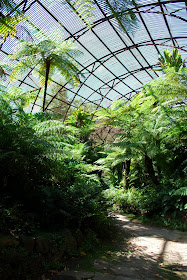 The fernery, or the 'Grand Shade House' at Rippon Lea, is home to over 230 species of ferns.*
The fernery, or the 'Grand Shade House' at Rippon Lea, is home to over 230 species of ferns.*
Coincidentally, the latest issue of the Garden Design magazine that dropped down two days ago in the mailbox was titled "The New Victorian Age". It was full of Victoriana and pteridomania (which translates to fern craze or fever), two tightly related subjects, and contained some remarkably beautiful, overexposed pictures of ferns by Bryan Whitney on its pages. Ferns have been a stable in gardens and as indoor plants since the Victorian times, but it seems that there is a renewed fever in the air, ferns popping up again in interior design, on sheets, prints and other decorative elements. And considering the many articles and garden books about the Victorian age that have been published lately, maybe there is something to the magazine's claim of the Victorian period's 'second coming'... we'll see.
*

The shady verandas and terraces leading to the gardens; my girls are having a rest from the heat in the white garden chairs...
*
All this focus on Victoriana ties nicely together with my recent visit to Rippon Lea in the suburb of Elsternwick in Melbourne. Rippon Lea is a national treasure that has since 2006 been included in Australia's top heritage listing. It is the last of the great privately owned 19th century suburban estates to survive largely intact in Australia. Built and developed between 1868 and 1903 by leading Melbourne businessman and politician Frederick Thomas Sargood, the house was designed in Romanesque style by Joseph Reed, then one of the most prominent architects in Melbourne. *
* The lake, with ornamental cast iron bridges - cast iron was another Victorian invention and favorite - leading from one side to the other.
The lake, with ornamental cast iron bridges - cast iron was another Victorian invention and favorite - leading from one side to the other.* *
Although the surrounding suburbia has crept closer and the Rippon Lea gardens now are reduced from their original size, they still are of international significance as an excellent example of Victorian garden making. The last owners of the Rippon Lea, Benjamin Nathan and his daughter Louisa Jones, preserved the gardens relatively intact, and they still retain many features from the times of Frederick Sargood: a lake, a mound and grotto, extensive lawns, a huge fernery, a conservatory and a serpentine carriageway. To sustain his extensive gardens through the hot Melbournian summers, Sargood designed a sophisticated underground irrigation system that was driven by a wind-mill that still exists on the grounds.
*

 The conservatory and a view from the fernery, constructed of cast iron arches supported by cast iron pillars, and covered with wooden slats.*
The conservatory and a view from the fernery, constructed of cast iron arches supported by cast iron pillars, and covered with wooden slats.*
How ferns reproduce was not properly understood until the 1830s. Once the mystery was solved (by accident in London) and nurseries could start propagating them, a fern craze swept over Great Britain and spread over to its colonies. A fernery became an essential element of large Victorian gardens, and as a passionate garden person, Frederick Sargood built in 1884 a 'Grand Shade House', a huge fernery imitating an Australian gully, to house his collection of more than 230 species from all around the world, including huge specimens of Australian tree ferns.
* The shady, serpentine drive way, overhang with Moreton Bay figs.
The shady, serpentine drive way, overhang with Moreton Bay figs. *
The day of our visit was hot, up to 38 degrees C (100 degrees F), so the long, winding driveway overhang with huge Moreton Bay figs (Ficus macrophylla) provided a longed-for, shady welcome to the estate of Rippon Lea. But even more welcome was the coolness of the Great Shade House where we lingered for a long time admiring its lush verdant inhabitants, their fronds filling the air like huge lacy tentacles, hanging from the walls and covering the ground with their intricate, leathery leaves. I could completely understand the Victorians' infatuation with ferns and ferneries, and thought I would be more than delighted with their revival - just like we have experienced the renaissance of stumperies, another Victorian folly, during the last decade. So new Victorians - what comes to ferneries, I guess you can count me in!
*
* More about Rippon Lea, Elsternwick near Melbourne, Victoria, Australia. 
Vad intressant!! Vad man lär sig saker på din blogg!!! Nu vet jag vad stumpery är också - och att de fanns redan på den viktorianska tiden. Aurikelteatrar är väl också något många suktar efter (men kanske inte så många har).
ReplyDeleteHa det gott!
/Ruben
Hej Ruben, vad roligt att höra från dig! Jag har saknat nya inlägg på din blogg, hoppas att det kommer något snart. Fast man behöver lite vila också, då och då. Visst är aurikelteatrar barn av samma tidsperiod, kul att du påminde om dem! Viktorianer var verkligen "ultimate gardeners". Även om estetisk det blir lite för mycket några gånger, är jag annars väldigt förtjust i den perioden och allt på gränsen till halvgalet de höll på med... Vilken entusiasm! Ha det så bra, Liisa.
ReplyDeleteÄlskar viktorianska växthus, vi har ju de i Kew på nära håll här. Kul det där med ormbunkes återintåg.
ReplyDeleteHa det gott.
ps. skrev ett litet svar på din kommentar på mitt bokinlägg.